
В.Н. Пармон. Кирилл Ильич Замараев
Л.А. Замараева. Мои воспоминания
Г.И. Скубневская. 40 лет в науке с тобой и без тебя
Мемориальная комната академика Кирилла Ильича Замараева
Программа мемориального семинара
"Физические методы для каталитических исследований
на молекулярном уровне".
П. Федотов. Россия и ИЮПАК.
За рубежом
Академик Кирилл Ильич Замараев - выдающийся российский ученый, крупный организатор науки, талантливый педагог, внесший большой вклад в развитие химической физики и науки о катализе.
К.И. Замараев родился 20 мая 1939 года в Москве в семье известного советского инженера-химика. Начав свою профессиональную подготовку в Московском химико-технологическом институте им. Д.И. Менделеева, Кирилл Ильич перешел в Московский физико-технический институт (МФТИ), чтобы серьезно заняться химической физикой. В 1966 г. он закончил аспирантуру в МФТИ, защитив диссертацию на соискание ученой степени кандидата физико-математических наук. С этого времени К.И. Замараев работал в Институте химической физики им. Н.Н. Семенова АН СССР в должностях младшего, старшего научного сотрудника, затем заведующего лабораторией и одновременно преподавал в МФТИ в качестве доцента.

В 1972 г. им была защищена диссертация "Исследование строения и реакционной способности комплексов переходных металлов при помощи электронного парамагнитного резонанса" на соискание ученой степени доктора химических наук по специальности "Физическая химия".
В 1974-1975 годах К.И. Замараев занимался исследовательской работой в США в Корнельском, Стенфордском и Чикагском университетах. Он был в числе первых советских ученых, приглашенных в Америку для долгосрочной работы по программе научного обмена в области химии между СССР и США.
В 1976 г. К.И. Замараев был избран членом-корреспондентом Академии наук СССР. В начале 1977 года по приглашению академика Г.К. Борескова К.И. Замараев переехал в Новосибирск с большой командой молодых специалистов по химической физике, значительно расширив проводившиеся в Институте катализа исследования элементарных каталитических реакций на молекулярно-атомном уровне с применением современных физических и кинетических методов.
С 1977 года К.И. Замараев занимал должность заместителя директора Института катализа СО АН СССР, а в 1984 году возглавил Институт. С этого момента и до последних дней жизни К.И. Замараев являлся его научным руководителем.
В 1987 году К.И. Замараев был избран действительным членом Академии наук СССР.
Много сил и энергии потребовало от К.И. Замараева создание новых организационных форм взаимодействия науки и промышленности. С 1986 по 1992 год он возглавлял межотраслевой научно-технический комплекс "Катализатор". Работа МНТК оказала большое влияние на коллектив Института катализа, усилила его способность работать с промышленными предприятиями. Именно в это время проявились великолепные организаторские качества Кирилла Ильича, сумевшего создать внутри Института высокоэффективный коллектив единомышленников, установивший деловые контакты с отраслевыми организациями, и обеспечить координацию их деятельности на общесоюзном уровне. Эффективная научно-организационная деятельность МНТК открыла двери в промышленность для новейших разработок прежде всего академических институтов, пробиться которым в прежние годы было практически невозможно из-за противодействия отраслевых институтов и работников министерств. За период деятельности МНТК были освоены около 30 новых технологий, на четверть обновлен ассортимент основных промышленных катализаторов и носителей.

Заседание дирекции Института катализа, 1981 г.
Слева направо: А.В. Федотов, Р.А. Буянов, Г.К. Боресков, К.И. Замараев, Ю.И. Ермаков.
К.И. Замараев был настоящим лидером МНТК. Жизненная энергия Кирилла Ильича воплощалась в жизненную силу коллектива Института. Поэтому при обвальном переходе на рыночные отношения в научно-технической сфере Институт катализа смог продемонстрировать высокую устойчивость и эффективность.

Первое заседание МНТК "Катализатор" во главе с генеральным директором К.И. Замараевым, февраль 1986 г.
В последние годы академик Замараев принимал активное участие в перестройке системы отечественной науки и ее адаптации к условиям рыночной экономики. Кирилл Ильич играл ведущую роль в формировании широкой сети Государственных научных центров Российской Федерации, призванных, совместно с Российской Академией наук, поддерживать основной научный потенциал России.
Являясь признанным лидером российского сообщества специалистов-каталитиков, академик Замараев проводил большую научно-организационную работу, был председателем Научного совета по катализу и его промышленному использованию, Объединенного научного совета по химическим наукам СО РАН.
К.И. Замараев принимал активное участие в подготовке научных кадров. С 1977 года являлся профессором и заведующим кафедрой физической химии Новосибирского государственного университета.
К.И. Замараев проводил активную работу по развитию международного сотрудничества. С конца 60-х годов он был ученым секретарем Национального комитета советских химиков, официально представлявшим интересы нашей страны в Международном союзе теоретической и прикладной химии (ИЮПАК). В 1987-1989 г.г. он работал Президентом отделения физической химии, затем в 1989-1993 г.г. членом Бюро, а в 1993-1995 годах занимал пост Президента Международного союза теоретической и прикладной химии, а затем пост-Президента. Доктор М. Вильямс, исполнительный секретарь ИЮПАК, вспоминает об этом времени: "Я был очень тесно связан с Кириллом по работе в ИЮПАК на протяжении нескольких последних лет (впервые я встретился с ним на Генеральной ассамблее в Вашингтоне). Это был изумительный человек, всегда дружелюбный, с огромным желанием сделать свою работу в ИЮПАК наилучшим образом. Это особенно ярко проявилсь во время продолжительных и трудных дискуссий о названиях трансфермиевых элементов. Его энтузиазм был очень заразителен!"
Кирилл Замараев, работая в комитете по публикациям ИЮПАК (1990-1993 г.г.), инициировал серию монографий "Химия для 21-го века" и вместе с Дж.М. Томасом стал редактором первого тома этой серии "Перспективы катализа".

Выступление президента ИЮПАК на заседании Исполнительного комитета, Гилфорд, Великобритания, 1994г.
С 1987 г. он возглавлял советскую часть проекта "Катализ" долгосрочной комплексной программы сотрудничества с Национальным центром научных исследований Индии.
О международном признании научных заслуг К.И. Замараева свидетельствует избрание его членом Академии Европы, иностранным членом Индийской и Корейской академий наук, редактором международных научных журналов.
Профессор Замараев был главным редактором международного журнала"Reaction Kinetics and Catalysis Letters", редактором"Journal of Molecular Catalysis", членом редакционных советов многих журналов:"Catalysis Reviews","Catalysis Today","Catalysis Letters","Topics in Catalysis","Chemistry - A European Journal","Mendeleev Communications","Chemistry for Sustainable Development", "Кинетика и катализ", "Успехи химии", "Известия Академии наук", "Журнал структурной химии" и др.
В 1994 году ему была присуждена Серебряная медаль Королевского химического общества Великобритании как выдающемуся лектору современности.

Санкт-Петербург, октябрь 1995 г. Вручение премии им. А.П. Карпинского
В 1995 году за работы в области экологического катализа К.И. Замараев был награжден престижной немецкой наградой для российских ученых - премией и медалью имени А.П. Карпинского.
К.И. Замараев внес крупный вклад в развитие теории и практики каталитической науки. Основополагающее значение имеют его работы по изучению механизмов каталитических реакций и структуры активных центров; исследования в области фотохимии и разработки реакторов для использования солнечной энергии; а также работы по изучению теоретических основ спинового обмена в растворах и его применения в химии.
Кирилл Ильич начал свою деятельность с исследования методом электронного парамагнитного резонанса строения комплексов переходных металлов в растворе. Хорошо известны его работы по интерпретации сложных спектров ЭПР замороженных растворов металлокомплексов, по определению связи магниторезонансных параметров со строением комплексов металлов. Параллельно им проводились фундаментальные экспериментальные и теоретические исследования спинового обмена в растворах парамагнитных комплексов металлов. Эти работы составили основу широко известных монографий по проблемам спинового обмена, изданных в России и за рубежом.
В середине семидесятых Кириллом Ильичем открыты и исследованы реакции туннельного переноса электрона на большие расстояния между парами реагентов, вмороженными в твердые нейтральные матрицы, была продемонстрирована возможность туннелирования электронов на расстояния 15-30 A и подробно изучена кинетика этого явления. Результаты этих работ были впоследствии изложены в монографии "Туннелирование электрона в химии", опубликованной в издательствах "Наука" и Elsevier. В это же время начат интересный цикл работ по изучению роли внешнесферной координации в механизмах каталитических реакций.
Кирилл Ильич был одним из пионеров исследования строения активных центров катализаторов и ключевых интермедиатов гомогенных и гетерогенных каталитических реакций методами ЯМР-, ЭПР- и ИЦР-спектроскопии. В частности, впервые были зафиксированы и охарактеризованы методом многоядерного ЯМР алкилпероксо- и пероксокомплексы молибдена - ключевые интермедиаты эпоксидирования олефинов. Методом твердотельного многоядерного ЯМР было исследовано строение активных центров широкого круга промышленно важных катализаторов, установлена природа соединений, ответственных за каталитические свойства, исследовано координационное окружение элементов, получены данные о природе поверхностных центров, об изменениях химической связи в молекулах при адсорбции, о природе промежуточных продуктов химических реакций. С использованием современных методик ЯМР детально изучены механизмы превращения спиртов и углеводородов на цеолитах, выяснена природа и определено строение интермедиатов, образующихся в этих реакциях. Открыты новые для цеолитного катализа пути превращения углеводородов.
В последние годы Кирилл Ильич уделял большое внимание экологическим проблемам, передовым технологиям. Наиболее известны его работы в области преобразования солнечной энергии в химическую, как основы развития безопасной для окружающей среды энергетики будущего, работы по фотокаталитическим реакциям и их влиянию на процессы, протекающие в атмосфере, а также работы по созданию новых катализаторов и каталитических технологий для защиты окружающей среды.
Работы К.И. Замараева составляют фундамент для развития каталитической химии будущего. Им опубликованы 3 монографии и более 300 научных работ в отечественных и зарубежных изданиях.
В повседневной жизни академик Замараев был общительным собеседником, любил и понимал шутки, заразительно смеялся, был непременным участником капустников, менделеевских вечеров. На вечере, посвященном 30-летию Института, всем запомнилась шутка "Что общего между Отелло и Замараевым? - Любовь к физическим методам". Кирилл Ильич весело смеялся над посвященными ему эпиграммами: "Поманил нас раем сибирским Замараев. Ах, мамочка, зачем?", "Нам буржуи продают приборы с осторожностью - вдруг откроет Замараев новые возможности".

"Народный артист Института катализа" с Ю.И. Аристовым и Е.П. Талзи на одном из вечеров, 1988 г. |
|
 На перевале Пскема в горах Тянь Шаня, 20 мая 1989 г. |
Академгородок, 20 мая 1989 г. |
Кирилл Ильич любил и понимал музыку, поэзию, наслаждался редкими моментами общения с природой. Свое пятидесятилетие он встретил с товарищами в горном походе.
В этот день - 20 мая 1989 г. - его ближайшие друзья и ученики, оставшиеся в Академ-городке, сделали на память фотографию, с посвященными ему стихами:
В пути к заснеженной вершине
Дыханье чаще, пульс быстрей,
Но в тот же час, что на равнине
Увы, настигнет юбилей.
Но мало повода к печали -
Успели высоту набрать.
Уже неплохо отшагали
И силы есть ещё шагать.
Неиссякаемая энергия, целеустремленность, творческая активность, безусловная преданность делу - это те человеческие ценности и идеалы, которые пронес Кирилл Ильич через всю жизнь.
21 мая 2004 г. в Институте катализа прошел семинар "Физические методы для каталитических исследований на молекулярном уровне", посвященный памяти академика К.И. Замараева, который был нашей скромной данью памяти ученого.
В.Н. Пармон,
академик,
директор Института катализа СО РАН
Кирилл Ильич Замараев родился в семье инженеров - химиков 20 мая 1939 года в г. Москве в Сокольниках. Отец, Илья Кириллович Замараев, был родом из разночинной интеллигенции: его папа, Кирилл Ильич, доцент Санкт-Петербургского политехнического института был за вольнодумство переведён в Томский технологический институт, где он до конца своей жизни (а умер он рано, в 57 лет) читал курс начертательной геометрии. Учебник, написанный его рукой, до сих пор хранится в мемориальной комнате в Институте катализа СО РАН. Мама, Ольга Ивановна, была школьной учительницей, преподавала русский язык и литературу. Опыт её преподавания был оценен при советской власти: она по приглашению
Н.К. Крупской выступала на съезде советских учителей. Илья Кириллович был младшим ребёнком в семье, он рано окончил школу, в 14 лет, и уехал из Томска в г. Москву, где вскоре продолжил своё образование, поступив в Московский химико-технологический институт им. Д.И. Менделеева.
Московская жизнь Ильи Кирилловича отличалась не только эффективной его работой как талантливого инженера-химика, но и разнообразием занятий и встреч в кругах московской интеллигенции. Среди его знакомых были Святослав Теофилович Рихтер, Нина Львовна Дорлиак, академик В.М. Родионов, Д.Н. Журавлёв и др. Все, кто с ним общался, помнят его остроумные шутки, эпиграммы и талантливые стихи. Он был очень весёлым и жизнелюбивым человеком, и до конца своих дней был главным советчиком в делах своего сына.
Мать, Вера Львовна Замараева, получила классическое для тех времён образование. Её учили музыке, языкам, приобщали к искусству. С 12 лет она регулярно смотрела все спектакли Художественного театра, поскольку ей был подарен театральный абонемент. Она мечтала стать актрисой. В школе играла в самодеятельных спектаклях. Родители не особенно одобряли это увлечение, они видели свою дочь профессиональной пианисткой. В конце концов случилось так, что Вера Львовна поступила в тот же Менделеевский институт и стала инженером-химиком. Театр оставался для Веры Львовны самым любимым занятием, но уже в свободное от работы время. Она играла в драмкружке и по-прежнему смотрела все самые интересные спектакли московских театров, посещала консерваторию.
Встреча Веры Львовны и Ильи Кирилловича произошла в стенах НИИ-42, закрытого химического предприятия, куда Веру Львовну направили после окончания института, и где Илья Кириллович в свои неполные 30 лет уже пользовался заслуженным авторитетом опытного инженера - проектировщика. Через год после их встречи родился сын - Кирилл.

Вера Львовна и сейчас помнит детство маленького Кирюши так детально, словно это было только вчера. Он не был красивым, но был очень весёлым ребёнком. Никогда не плакал, с ним не было никаких хлопот. Родители Веры Львовны - бабушка и дедушка - не чаяли в нём души, помогали его растить, и жизнь была очень интересной.
Но тут началась Великая Отечественная война. Тяжело заболела мама Веры Львовны, папа её пошёл в ополчение. Илья Кириллович жил на военном положении на своём сверхсекретном оборонном предприятии, и Вера Львовна с двухлетним сыном жила одна в деревянном доме в Сокольниках. Начались бомбёжки, приходилось бежать с ребенком на руках на станцию метро "Сокольники". Ближе бомбоубежища не было. Там дети, успокоившись, засыпали. А Кира не спал, он ждал, когда объявят отбой воздушной тревоги. Как только раздавалось:"Граждане, отбой...", он оживленно лепетал: "Мама, мама, он сказал: " граждан, уже отбой, уже домой!", и так повторялось изо дня в день...
В августе 41 года было принято решение об эвакуации женщин с детьми из Москвы. Илья Кириллович не хотел отпускать жену с сыном в эвакуацию, но папа Веры Львовны настаивал, он надеялся, что мама её вскоре поправится и тоже уедет к дочери и внуку. Но мама, которой только исполнилось 52 года, не поправилась после тяжёлого инсульта, и Вера Львовна её больше никогда не увидела.
В конце августа 41 года они ехали в теплушке 16 суток до Новосибирска. Вещи у них украли, продукты кончились. Дети болели, многие, не вынеся трудной дороги, погибали. Кирилл от недоедания и холода ослаб и перестал ходить. Нужно было раздобыть еды. В Новосибирске они вышли в поисках продуктов, но перрон был пуст, пошли подальше, но и там ничего... Когда вернулись, их поезда не было. Совершенно случайно какая-то женщина указала им путь, где стоял их состав. Их место в теплушке оказалось занято, и оставшиеся два дня они ехали на открытой платформе, и мать держала над ребёнком развёрнутое одеяло, чтобы хоть как-то защитить его от пронизывающего холодного ветра.
В эвакуации в Томске жили у родных Ильи Кирилловича. Там мальчик поправился, но пережитое чувство голода оставило свой след. Он необыкновенно радовался, когда Марья Марковна, жившая в Томске ещё в семье его деда Кирилла Ильича, готовила свои необыкновенно вкусные супы: "Ура! Уже идёт, уже несёт!". Кирилл уже в 2,5 года был очень ответственным человеком, его можно было отпускать гулять одного(!), предупредив, что уходить со двора нельзя. И он не уходил. Вскоре приехал Илья Кириллович и забрал Веру Львовну и Кирушу в Кемерово, куда было эвакуировано его предприятие. Жили в Доме крестьянина, там был только чёрный хлеб и кипяток. Только через какое-то время стали появляться кое-какие продукты. Там, в Кемерово жил в эвакуации со своей семьёй академик Н.М. Жаворонков, хорошо знавший семью И.К. Замараева. "Как тебя зовут, мальчик?" - "Кила Замалаев". "Ты прочно стоишь на ногах, Кира Замараев", - сказал академик Жаворонков. В этот вечер Илья Кириллович спросил: "Так как же тебя зовут, Кила или Кира?" Ночью родители услышали шепот мальчика: "Кила - Кира, Кила - Кира". С этого дня он стал говорить правильно. Весь институт НИИ-42 остался в Кемерово, а Илью Кирилловича вызвали в Дзержинск.
В 1943 году Вера Львовна отметила четвёртый день рождения Кируши в поезде по дороге домой, в Москву. Перед отъездом в Москву Вера Львовна ездила в деревню Плешки, где обменяла все вещи на продукты - картошку, муку, лук, масло. В Москве был голод. Всё было по карточкам. Понятно, что все детские игры были на военные темы. Спать уложить было невозможно. "Военные рано спать не ложатся", - звонко отвечал Кира маме, когда она отправляла его в постель.
Потом был Дзержинск, где Илья Кириллович восстанавливал по памяти завод по производству синильной кислоты. Впоследствии за пуск этого производства в военные годы Илья Кириллович Замараев был награждён Сталинской премией. Это была вторая Сталинская премия по счёту, присуждённая в Советском Союзе.
Кира в Дзержинске встал на лыжи. В четыре с половиной года он спускался на лыжах с таких крутых гор, что у родителей от волнения за него захватывало дух, но они и вида не показывали - нельзя ведь, чтобы мальчик вырос трусом. В 1945 году семья вернулась в Москву и снова стала жить в Сокольниках. В пять лет весёлого и активного мальчика отдали в детскую группу, где воспитателем была француженка мадам Шевалье. Она гуляла с ребятами в парке Сокольники. Детей везли к ней со всей Москвы. И вот картина: мадам Шевалье мирно дремлет в парке на скамеечке, а маленький Кирилл увлекает детей своей игрой, фантазируя и придумывая какие-то необыкновенные занятия. Когда Вера Львовна пришла к мадам, чтобы заплатить деньги за её занятия с Кириллом, та замахала руками: "Что Вы, что Вы, он же мой помощник и не доставляет мне никаких хлопот". Он мог играть с очень простыми вещами, наделяя их необыкновенными свойствами. Игрушек не было, любимыми игрушками были камень и палка. Жили дружно, было много друзей, с ними ездили отдыхать. Однажды вместе с семьёй Журавлёвых отдыхали на Волге в Плёсе. Тогда родители стали замечать, что на прогулках Кируша отстаёт. "Ты устал, сынок?",- спрашивали они. "Устал, но ведь и Вы устали", - отвечал он.
На день рождения в 6 лет Кире подарили двухколёсный велосипед, и он самозабвенно на нём катался. Однажды неудачно свалился с велосипеда и больно ударился бедром. Боль на какое-то время утихла, но потом возобновилась с новой силой. Врачи поставили грозный диагноз: туберкулёз тазобедренного сустава. В те времена не было лекарств от этой болезни. Лечили укладыванием в гипс и в больничную постель на полгода. Переживали эту беду страшно. Нашли хорошего врача - Зинаиду Юлиановну Ролье. Она сказала: "Не будем его класть в гипс, но с одним условием: режим полупостельный, свежий воздух, питание, богатое овощами и фруктами, и неусыпное внимание мамы. Раз в 3 месяца привозите его ко мне - если не будет ухудшения, будем продолжать лечить дома. Родители внушают мне доверие, если мама может всё бросить и целиком сосредоточиться на сыне". Дома Кира изучил программу начальной школы с помощью своих родителей и научился самостоятельно работать с книгой. Недалеко от дома был книжный магазин, и Кирилл очень любил туда ходить, разглядывая новые для него книжки.
В эти годы Кирилл получил от отца подарок - книгу о Майкле Фарадее, которую в 90-е годы передал в музей М. Фарадея в Лондоне. Такой книги в этом музее не было.
Вся семья строго выполняла рекомендации Зинаиды Юлиановны Ролье, так что больной мальчик пошёл на поправку. Среди увлечений маленького Кирилла было строительство дворцов из большого набора кубиков. Думали даже, что он станет архитектором, так красиво было то, что у него получалось. Он строил города, по улицам которых ездили игрушечные автомобили. Города были выстроены очень удобными, гармонично сочетающими в себе архитектурную красоту и функциональность.
Это чувство архитектурной гармонии было присуще Кириллу и в его взрослые годы. Устав от работы дома над своими научными статьями, он приходил в домашнюю гостиную и занимался там перестановкой вещей, перевешиванием картин, расстановкой в каком-то новом варианте фигурок на полках и на пианино, ища тот единственный вариант, когда гармония становилась полной. Путешествуя по миру в своих научных командировках, он всегда находил время полюбоваться красотой творений древних архитекторов, любил и знал древнерусскую архитектуру, отдавая предпочтение самым простым классическим формам. Кирилл за всё своё детство не сломал ни одной игрушки, он был строитель, созидатель, и это качество его характера очень помогло ему в последующей работе в качестве организатора науки.
Под неусыпным контролем родителей Кирилл уже достаточно выздоровел, чтобы ходить в школу вместе с другими ребятами. В этот год в Сокольниках открылась первая в Москве английская школа Наркомпроса. Набор был в четвёртый и шестой классы. Кирилла привели в четвёртый класс. После собеседования он был принят с условием, что за два с половиной месяца он "подтянет" английский до требуемого в школе уровня. Английского языка Кирилл тогда не знал совсем. Но он его "подтянул", и очень скоро стал лучшим в классе. Подбор учителей в школе был великолепный. Учились дети известных людей - творческой интеллигенции, членов правительства. Но все дети были скромными, никто не выделялся по принципу известности родителей.

Кирилл учился отлично всегда, а когда родители замечали, что он выглядит уставшим, то просто забирали его из школы, и он занимался дома. Врачи давали ему такое право. Жизнь в школе была очень интересной. Мальчики (школа была мужская) ставили пьесы Маяковского, Кирилл играл "Человека будущего". Эта его роль может стать названием книги о нём, если кто-нибудь её напишет, потому что он и был Человеком будущего. Преподавательница английского языка, Эльга Абрамовна, говорила родителям Кирилла: "Он у вас устрашающе умный". Преподаватель литературы считала, что он должен посвятить себя гуманитарным наукам, поскольку высоко оценивала его логику и способности в области истории и литературы. Ему же нравились химия, физика и математика. Выпускные экзамены Кирилл сдал на "отлично" и получил золотую медаль.
Родители посоветовали поступать в Менделеевский, который заканчивали сами. Он прошёл собеседование и был принят. Учёба в этом вузе была для Кирилла одно удовольствие: в сессию, когда основная масса студентов корпела над конспектами и учебниками, он много гулял, отдыхал, ходил в кино, поскольку регулярные занятия в течение семестра позволяли ему хорошо усваивать учебный материал. В 1957 году в Москве проходил Международный фестиваль молодёжи и студентов. Студента первого курса Кирилла Замараева по комсомольской линии направили в бюро по приёму почётных гостей фестиваля для помощи в работе с иностранными гостями. Родители рассказывали, что он был прикреплён к министру торговли из Индии по имени Малавия. Английский его здесь очень пригодился, министр был вегетарианец, кормить его было сложно, но Кирилл опекал его до глубокой ночи, стараясь как можно полнее показать жизнь и культуру советских людей. Он был Сталинским стипендиатом, участвовал в общественной жизни факультета, но, как оказалось, удовлетворения от учёбы не испытывал. Однажды после экзаменов пришёл домой невесёлый. "Мне нужно больше знаний в области физики и математики, чем дают в Менделеевском", - сказал Кирилл маме. Самым мощным вузом, дающим необходимое образование в области физической химии, с серьёзнейшей математической подготовкой, был Московский физико-технический институт. Кирилл поехал туда вместе со своим ближайшим школьным другом Валей Васильевым (сейчас профессор МАИ). Валя после школы поступил в Московский авиационный институт и тоже испытывал некоторую неудовлетворённость от учёбы в нём. Заместителем декана на выбранном ими факультете в то время был профессор Волкогон. Он откровенно предупредил ребят, что программа на Физтехе абсолютно отличается от всех вузов, им придётся переходить с потерей курса и с досдачей 13 экзаменов. Валя Васильев не стал переходить, а Кирилл Замараев решил все-таки попробовать свои силы и перешёл на Физтех. Было решено, что если он сумеет самостоятельно подготовиться к сдаче первой сессии и сдаст её, то часть предыдущих экзаменов можно будет не сдавать. Было очень трудно, занимался сверх всякой меры, уставал. Но сессию сдал на "отлично". На Физтехе Кирилл реализовал свои способности полностью. В аспирантуру Кирилл поступил к В.В. Воеводскому, в то время одному из наиболее талантливых учёных в области химической физики. Когда пришла пора защищать кандидатскую диссертацию, от В.В. Воеводского, который тогда уже работал в Новосибирском Академгородке, пришёл такой отзыв: "Работа выполнена аспирантом К.И. Замараевым абсолютно самостоятельно, без всякого моего участия". В.В. Воеводский всю жизнь служил для Кирилла примером самоотверженного служения науке, личной скромности и принципиальности. Он никогда не подписывал статьи своих учеников, если не чувствовал своего вклада в их работу.

По окончании аспирантуры и защиты кандидатской диссертации Кирилл Замараев поступил на работу в Институт химической физики АН СССР. Там он вскоре был замечен академиком Н.Н. Семёновым, лауреатом Нобелевской премии, возглавлявшим этот институт. Работать с Н.Н. Семёновым было необыкновенно интересно, но и очень трудно, т.к. он привык работать по ночам. Бывало, только Кирилл вернётся домой, поужинает, вдруг звонок Николая Николаевича: "Не могли бы Вы, Кирилл, приехать сейчас ко мне? В голову пришла одна мысль...". И он снова ехал работать. Н.Н. Семёнов оценил научный потенциал молодого Кирилла Замараева очень высоко: " Как у нас одинаково работает мысль, я только подумаю, а Вы уже говорите". Годы работы с академиком Семёновым стали основополагающими в работе по разработке солнечной энергетики. Сейчас этим направлением в Институте катализа занимается ученик К.И. Замараева академик В.Н. Пармон.
Одновременно с работой в Институте химической физики К.И. Замараев работал преподавателем-совместителем на Физтехе. По сей день многие вспоминают семинары, которые он вёл на английском языке, чтобы студентам в будущем легче было на международных конференциях понимать смысл научных докладов иностранных учёных. Позднее, в Новосибирском Государственном университете Кирилл Ильич продолжил свою преподавательскую деятельность.
В те же годы у Кирилла Ильича появилась работа на международном поприще: он был избран учёным секретарём комитета советских химиков, официально представлявшего нашу страну в ИЮПАКе - международном союзе теоретической и прикладной химии при ООН. Благодаря этой работе он рано стал известен в кругу самых известных учёных-химиков всего мира. После защиты докторской диссертации в 1972 году Кирилла стали приглашать многие научные центры нашей страны.
Одним из первых советских химиков, выехавших в длительную командировку в США по межправительственному соглашению об обмене научными работниками, был Кирилл Замараев. В 1974 - 1975 г.г. он работал в трёх крупнейших научных центрах США - Чикагском, Стенфордском и Корнельском университетах. Результатом этой научной командировки стало множество научных статей, написанных в содружестве с американскими учёными. Вот только английский язык приобрёл американский акцент. "Кирилл, что Вы сделали со своим английским?",- спросила при случайной встрече на конференции его учительница английского языка Эльга Абрамовна.
А в 1977 году после избрания его членом-корреспондентом АН СССР, Кирилла пригласил в Институт катализа академик Г.К. Боресков, глава школы советских химиков - каталитиков. Перспективы для работы в Сибири были прекрасные, и Кирилл Ильич согласился.

Поехали в Новосибирский Академгородок уже целым коллективом: Кирилл Ильич с женой и сыном, и ещё 9 человек молодых научных сотрудников, решивших не расставаться со своим шефом.
Академгородок - это лучшее место в нашей стране для работы и жизни людей науки. Высочайшая концентрация научных институтов, работающих в разных и смежных областях науки, великолепный университет, подкреплённый не только преподавателями-сотрудниками из этих институтов, но и созданной в советские годы физико-математической школой, которая собирала лучших ребят страны, живущих к востоку от Урала.
Кирилл Ильич с головой окунулся в работу на новом месте. Огромная организационная работа в Сибирском отделении АН СССР и в Институте катализа оставляли совсем мало времени для занятий его главным делом жизни - наукой. Но он рано вставал, иногда в 5 утра, чтобы сделать намеченную на этот день научную работу. Без науки для него не было жизни.
Сибирская жизнь захватывала своими перспективами. Окружающая природа помогала восстанавливать силы. Кирилл вместе с друзьями - любителями горных походов каждое лето ходил в горы. Его товарищами в этих путешествиях были такие известные в науке люди, как академики Д.Г. Кнорре, Ю.Н. Молин, В.П. Мамаев. Кирилл Ильич привлёк к этим походам и сотрудников Института катализа. С ним ходили в горы и Ю.И. Ермаков, и В.А. Лихолобов, и его ученик Е.Н. Савинов. Если в студенческие годы любимым отдыхом Кирилла были байдарочные походы по северным рекам, то теперь он не мог прожить ни одного лета без гор. "Лучшего способа отвлечься от суеты рабочих будней не существует",- говорил он. Друзья по этим походам очень высоко ценили Кирилла за способность измерить степень опасности, вовремя принять необходимые меры предосторожности, взять на себя самый сложный участок работы и протянуть руку помощи. Он был очень надёжен и поддерживал у друзей бодрость духа в сложных ситуациях. Своим оптимизмом, находчивостью и умением улаживать конфликты, неизбежные в трудных ситуациях, Кирилл привлекал к себе людей, и поэтому всегда был желанным участником в любых походах. Они исходили всю Среднюю Азию, походы были высокой степени сложности, были даже на "пятитысячнике".
Когда подрос сын Илюша, Кирилл взял его с собой в горы. "Знаешь, папа, мне не очень нравится лазать по горам, потому что я плохо чувствую себя на высоте", - сказал папе Илюша. И получил совершенно неожиданный ответ: "Я тоже чувствую себя на высоте не очень приятно, так было всегда. Но я это преодолеваю, это помогает вырабатывать характер, в жизни требуется быть стойким". Тут можно добавить слова знаменитого путешественника Тура Хейердала: "...только так из мальчика получается мужчина". Преодоление трудностей в жизни было необходимо Кириллу для постоянной проверки своих человеческих возможностей. Это было, конечно же, заложено его воспитанием во время болезни в детстве, продолжилось в процессе сложнейшего перехода из Менделеевского института на Физтех. Дальше в своей жизни он всегда ориентировал себя на самые большие и сложные задачи, которые успешно решал.
Вот как оценивал его работу по реформированию науки, созданию системы ГНЦ министр науки в 1992 году Б.Г. Салтыков: "Кирилл Ильич обычно прилетал (в Москву) за несколько дней до очередного заседания комиссии (Правительственная комиссия по научно-технической политике) и, разобравшись с документами, обязательно беседовал с руководством управлений Министерства, думал и взвешивал. Боялся ошибиться, обидеть. Но когда он был в чём-то убеждён, то сдвинуть его было почти невозможно. Можно было сказать, что в этом вопросе мы были за ним, как за каменной стеной. Кирилл Замараев играл в этой истории много ролей - и генератора идей, и добросовестного чиновника, и чуткого психолога".
Жизнь и работа в Новосибирском Академгородке приносила Кириллу Ильичу большое удовлетворение. Он оставался весёлым и общительным человеком, очень любил концерты в Доме Учёных, помог приобрести для него новый концертный рояль. Кстати, благодаря его прямому вмешательству музыкальная жизнь городка, чуть было не погасшая вовсе, когда А.М. Кац отказался привозить своих оркестрантов в ДУ, вновь возродилась, и сейчас ДУ является одним из популярнейших мест, где выступают самые знаменитые российские и зарубежные музыканты.
Музыка в жизни Кирилла Ильича играла огромную роль. Он говорил, что она организует мысли, он мог работать при включённой записи концертов Баха, Рахманинова, Бетховена. Лучше всего отдыхал, если слушал классику. Знал её превосходно, мог отличить на слух исполнение одного музыканта от другого. Его душа требовала музыки так же, как тело - пищи. Но духовной пищей для него была и живопись, и архитектура, и поэзия. Особенно любил Пушкина. Читал его наизусть. Много помнил из Гумилёва.
Пока наши дети были маленькими, он ездил в заграничные поездки и привозил оттуда множество слайдов. Потом по вечерам мы все собирались в его домашнем кабинете, он показывал сделанные снимки, рассказывал массу интересных историй о городах и людях, с которыми он познакомился. Дети рассматривали великолепные альбомы по искусству, которые привозил папа. Позднее, когда мы смогли ездить за рубеж вдвоём, я смогла воочию убедиться в том, как много знал Кирилл Ильич о зарубежной истории, культуре, искусстве, архитектуре. Знания его были эциклопедичны, а память обладала способностью в нужный момент выдать необходимую информацию. Мы осмотрели лучшие древнерусские храмы Москвы и Подмосковья, Пскова, Новгорода и Санкт-Петербурга, музеи Берлина - Пергамон и Далем, Парижа - Лувр, Нотр Дам, Лондона - Британский музей и музей Науки, Лиссабона - музей современного искусства, музей Гюльбикяна, Тбилиси - музей Пиросмани, дом-музей художницы Елены Авхледиани, и конечно же - Эрмитаж, Русский музей и ещё много других интересных мест в Санкт - Петербурге и Москве.

Особенно интересно прошла наша поездка в Великобританию. В 1992 году Королевское научное общество Великобритании выделило Кириллу Ильичу стипендию имени П.Л. Капицы для двухмесячной работы в научных центрах Великобритании. Он решил, что мы поедем вдвоём на эту стипендию, а свою работу, расчитанную на два месяца, он сделает за пять недель. Огромную роль в организации этой поездки сыграл профессор Кембриджского Университета, в то время директор института имени Майкла Фарадея в Лондоне, Сэр Джон Мьюриг Томас. Лекции Кирилла Ильича прошли в пяти крупнейших научных центрах Великобритании, в том числе в знаменитейшей Кавэндишской лаборатории, где в своё время работал Пётр Леонидович Капица. Именно там по окончании лекции со своего места поднялся английский профессор, имя которого я, к сожалению, забыла, и предложил поаплодировать профессору Замараеву прежде всего за его прекрасный английский язык, который сами англичане уже стали забывать. Мы побывали в Уэльсе в Кардиффском университете, Оксфорде, Кембридже и в Лондоне. Жили в Лондоне в общежитии для преподавателей Империал Колледжа, недалеко от Гайд Парка. Мы часто ходили туда гулять, наблюдали конные прогулки королевских гвардейцев, известные сборища стихийных ораторов, спортивные игры студентов. Наслаждались великолепными цветами в парке Сент Джеймс, любовались совершенными английскими газонами. Очень красивым было зрелище смены караула у Букингемского дворца. Совершенно неожиданно для меня было увидеть напротив дворца английской королевы скульптуру рабочего и крестьянки, абсолютно по-мухински взявшихся за руки, но при этом опирающихся на льва - символ Британской Империи. Кстати, скульптура рабочего и крестьянки находится в окружении скульптур богов (!), вот какое место рабочим людям в жизни Британии отводилось британскими королями. По вечерам мы ездили на метро на улицу Пикадилли, гуляли, смешавшись с толпой отдыхающих людей. Во время нашей поездки в Лондон мы побывали на прекрасном концерте в знаменитом Альберт Холле, где я с удивлением увидела на стенах фотографии российских музыкантов, выступавших там ранее. Особенно много было там фотографий Арама Ильича Хачатуряна. Везде, где мы были вдвоём с Кириллом, мне было очень интересно. Он открывал мне новые страницы мировой истории и культуры.
В быту он был очень скромным человеком, не любил ресторанных обедов, предпочитая им простую домашнюю кухню. Одевался скромно, даже шапку ондатровую не любил носить зимой, поскольку у большинства людей в городке таких шапок не было. "Не хочу я выглядеть начальником", - объяснял он нам это. Внешность его, яркую и импозантную, не могла скрыть даже самая простая одежда, потому что выражение всегда улыбающегося лица и внимательный взгляд привлекали внимание окружающих, выдавая его неординарную личность.
С детьми он был очень терпелив, добр, но требователен. Я не всегда понимала, что капризы маленькой дочери - это не просто капризы, а своеобразное проявление её самостоятельного характера. Он видел её характер, объяснял мне, что необходимо с ним считаться. Она позднее говорила мне, что папа-то её хорошо понимал... Правда, она и меня оправдывала, видя, как много мне приходится в семье брать на себя из-за страшной занятости отца. Для меня само присутствие дома Кирилла было гарантией того, что дети будут вести себя хорошо, все дела сделаются, и беспокоиться ни о чём не надо. Отличительной чертой характера Кирилла Ильича было то, что он обо всём думал и беспокоился сам. Очень ответственный был человек и в большом, и в малом. Как на работе, так и дома. Особенно это было важно, если дети болели, капризничали, плохо ели. Папа с потрясающей фантазией каждый день рассказывал им многосерийные сказки о животных, изображая голосом всех действующих лиц так, что характер каждого из них был сразу ясен. В его отсутствие я и сама начала придумывать для них новые сказки и добивалась аналогичных результатов. Кирилл Ильич вообще любил детей, ценил в них талант, всячески помогал его развитию. Он, пользуясь своим авторитетом в международных научных кругах, не раз помогал нашим талантливым молодым людям попасть на стажировку в ведущие мировые научные центры. Отзывчивый он был человек, неравнодушный, помогал в трудные моменты жизни всем, кто к нему обращался. Однажды во время его лекций в Великобритании мы были в гостях у семьи Капицы, в доме, который принадлежал нашему русскому академику Петру Леонидовичу Капице. Вдруг услышали игру на скрипке. "А это ваша землячка, юная скрипачка Наташа Ломейко, она учится у Иегуди Менухина. Сейчас каникулы, а у неё нет денег на дорогу домой", - сказал Сергей Петрович Капица. По возвращении в Академгородок Кирилл Ильич организовал сбор денег на билеты для юной скрипачки. Наташа приехала к своим родителям, музыкантам из симфонического оркестра Новосибирской филармонии. Сейчас она стала известной во всём мире скрипачкой и приезжает в Новосибирск на гастроли.
Особое место в жизни Кирилла Ильича занимала его работа в Международном союзе по теоретической и прикладной химии (ИЮПАК). Огромный опыт научной и организаторской работы, в сочетании с высокой культурой и энциклопедической образованностью снискали ему большое уважение и доверие в среде деятелей ИЮПАКа. Наивысшим проявлением которого стало внеочередное избрание Кирилла Ильича Замараева в 1993 году на пост Президента ИЮПАКа по инициативе учёных западных стран. Ситуация была непростая. Назревал конфликт, и действующий Президент подал в отставку. Нужен был человек, который бы устроил всех и одновременно быстро вошёл бы в курс всех дел. Предложили русского учёного К.И. Замараева, которого избрали единогласно.
"Железная рука в бархатной перчатке", - так охарактеризовал его способ руководства один из ведущих сотрудников этой международной организации профессор М. Вильямс, работавший в этой организации со дня её основания.

Кирилл Ильич продолжал эту работу до 1994 года, а затем ещё два года в качестве пост-Президента. Есть там такая должность. Несмотря на тяжелейшую болезнь, из стен больницы он диктовал по телефону важные отчётные документы, произнося английские слова так чётко, что на другом конце провода всё воспринималось безошибочно.
Это тяжелейшее время своей жизни Кирилл Ильич переносил с невероятным мужеством и терпением. Вот как об этом пишет
Б.Г. Салтыков, который как только мог помогал Кириллу Ильичу справляться с болезнью:
"Все знают, что академик Замараев был выдающимся учёным, прекрасным педагогом и крупным организатором науки и промышленности. Но я не могу не сказать о его невероятном человеческом мужестве. Когда беспощадная болезнь настигла его и ему сделали первую операцию, то врачи вынесли приговор - "он проживёт полтора-два месяца". Он прожил два года. И, не умаляя заслуг врачей, скажу, что я уверен, что он вырвал эти два года благодаря невероятной воле и жизнелюбию. Остаётся только склонить голову перед его мужеством и талантом".
В знак глубокого уважения к личности Кирилла Ильича Замараева, до конца своих дней честно исполнявшего обязанности пост- президента, ИЮПАК принял решение стать одним из учредителей Международного благотворительного научного Фонда, носящего имя К.И. Замараева. Организованный в Новосибирске в 1997 году фонд ежегодно проводит конкурсы научных работ на соискание именных стипендий среди студентов и аспирантов, занимающихся исследованиями в области химического катализа и физикохимии поверхности. Свыше 100 лауреатов конкурсов Фонда получили стипендии имени К.И. Замараева, несколько человек получили гранты на участие в международных научных конференциях, проводимых в США. Надо сказать, что Северо-американское каталитическое общество откликнулось на идею организовать Фонд в память о Кирилле Ильиче Замараеве и регулярно в рамках этого фонда выделяет деньги на участие нашей молодёжи в научных конференциях по катализу, проводимых в США. Американскую ветвь Фонда возглавляет известный американский учёный в области катализа профессор Алекс Белл.
Память о Кирилле Ильиче Замараеве, блестящем ученом и замечательном человеке, жива. Она жива, пока живы люди его знавшие. Со своими воспоминаниями о Кирилле Ильиче они выступают на мемориальных научных семинарах и конференциях. Ученики продолжают развивать научные направления, которые были им начаты. Особенно большая роль в сохранении этой памяти принадлежит Институту катализа имени академика Г.К. Борескова СО РАН. Этому Институту К.И. Замараев отдал большую часть своей короткой, но яркой жизни. Поэтому Институт стал генеральным спонсором МБНФ им. К.И. Замараева. Каждый год в Институте проходят Мемориальные научные семинары, приуроченные ко дню 20 мая - дню рождения Кирилла Ильича Замараева. Каждый год всё новые и новые аспиранты и студенты получают за свою научную работу стипендии Фонда имени К.И. Замараева. Множество людей принимают участие в проведении конкурсов на соискание именных стипендий Фонда. Люди вносят свой посильный вклад в дело сохранения памяти о К.И. Замараеве. Можно надеяться, что его научная и просто человеческая жизнь оставила после себя глубокий след, частицу которого во всём мире несут молодые учёные России.
Л.А. Замараева

Автор воспоминаний в Мемориальной комнате - офисе МБНФ им. К.И. Замараева
* В рассказ включены воспоминания Веры Львовны Замараевой - мамы Кирилла Ильича, записанные автором заметки накануне его 65-летия
Наша первая встреча с Кириллом Ильичем Замараевым состоялась в 1965 году, когда Владислав Владиславович Воеводский вернулся из командировки в Москву вместе со своим московским аспирантом Кириллом.
 Этот улыбчивый, остроумный и большой исследователь сразу заполнил все пространство вокруг спектрометра ядерного магнитного резонанса в маленькой комнате. Буквально на следующий день Кирилл, Юрий Молин и я приступили к изучению парамагнитных сдвигов в спектрах ЯМР этилендиамина при комплексообразовании с двухвалентным никелем на первом в Академгородке спектрометре фирмы "Jeol", который открывал нам электронные тайны и картину перераспределения спиновой плотности с иона на лиганд при формировании сферы комплекса. Работа шла споро - я готовила растворы, Юра снимал спектры, Кирилл обрабатывал результаты.
Этот улыбчивый, остроумный и большой исследователь сразу заполнил все пространство вокруг спектрометра ядерного магнитного резонанса в маленькой комнате. Буквально на следующий день Кирилл, Юрий Молин и я приступили к изучению парамагнитных сдвигов в спектрах ЯМР этилендиамина при комплексообразовании с двухвалентным никелем на первом в Академгородке спектрометре фирмы "Jeol", который открывал нам электронные тайны и картину перераспределения спиновой плотности с иона на лиганд при формировании сферы комплекса. Работа шла споро - я готовила растворы, Юра снимал спектры, Кирилл обрабатывал результаты.

Мы наблюдали удивительную внутреннюю жизнь комплексов - положение линий лиганда зависело от положения координации в первой сфере иона металла. Тогда это было внове, и, расставаясь глубокими вечерами, мы горячо обсуждали, как это понять и обьяснить. Владислав Владиславович наведывался к нам, подзадоривал своей необьятной фантазией и, довольный увиденным, торопился дальше. Ощущение творческого подьема от со-творчества с Кириллом в эти летние дни сохранилось у меня и поныне. Но этот научный рай в шалаше ЯМРа оборвался в одночасье - Кирилла с коликой увезли в Москву, а мы с Юрой доводили начатые опыты до конца и торопились, чтобы порадовать нашего друга. Вскоре появилась наша единственная совместная статья в журнале Структурной химии 1966 года, положившая начало не только научным контактам, но и дружбе на всю оставшуюся жизнь.
Следующим этапом наших творческих контактов стала общая тематика исследований электронного спинового обмена, которую Владислав Владиславович начал параллельно в Москве и Новосибирске. Кирилл с коллегами и я изучали закономерности спинового обмена с участием стабильных свободных радикалов и парамагнитных комплексов в разных системах.
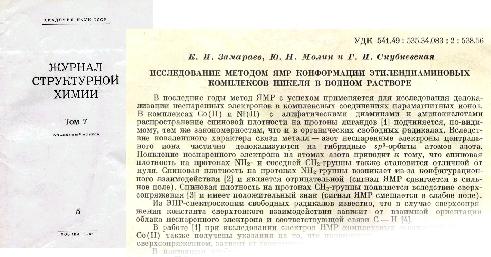
Я всесторонне изучала спиновый обмен иминоксильных свободных радикалов с комплексами двухвалентного никеля и кобальта. Сложность извлечения константы спинового обмена из наблюдаемого уширения линий ЭПР радикала под воздействием Ni (2+) и Co(2+) с короткими временами релаксации была преодолена благодаря помощи теоретиков. Логика исследований диктовалась главной целью - определить, каким образом распределение спиновой плотности по лигандам сказывается на эффективности спинового обмена, и можно ли от ситуации сильного обмена перейти к слабому посредством замены лигандов в координационной сфере. Кирилл и его коллеги изучали более широкий спектр систем, содержащих несколько типов парамагнитных частиц. В этот период мы часто общались, обсуждая результаты и вместе экспериментируя. Однажды в разгаре съемок спектров на новеньком ЭПР спектрометре фирмы "Varian" вышел из строя насос "Кама", который приспособили для подачи охлаждающей воды в магнит спектрометра. Кирилл не растерялся, побежал в подвал, принес "Каму" и, повозившись, наладил насос. Все заработало, а я оценила достоинства Кирилла-экспериментатора, который не теряется в сложных ситуациях.
Позднее, когда Кирилл Ильич переехал с семьей в Новосибирск уже в должности заместителя директора Института катализа АН СССР, не раз приходилось наблюдать его поразительный талант преодолевать трудности, где бы они не возникали, принимая их на себя. Ни звания, ни высокие должности не отразились на его характере общения. Звание лектора века было присвоено ему по-праву. Слушая лекции Кирилла Ильича по кинетике в НГУ, я была очарована его талантом общения с молодежью - скучные бимолекулярные реакции послужили поводом "между строк" напомнить строчки Пушкина, отметить, что компьютер должен прилагаться к мозгу, а не наоборот, и на доступном для современной молодежи языке заинтересовать бимолекулярными процессами в контексте с политическими событиями тех дней. Виртуозность лекций Кирилла была обусловлена его энциклопедической эрудицией и ораторским талантом истинного интеллигента и гражданина.
В последние годы мы встречались с Кириллом на заседаниях Президиума СО РАН по поводу экологических проблем, химии атмосферы и окружающей среды. Нередко мнения по тому или иному вопросу разделялись, возникали напряженные моменты, мало кто решался перечить Председателю Отделения В.А.Коптюгу. И тогда шуткой к месту и разговором издалека на ту же тему Кирилл Ильич разряжал обстановку, и стороны приходили к согласию без ущерба для существа дела. Он никогда не оставался равнодушным к проблемам жизни. Как блестели его глаза, когда он понял, что ожидавшееся похолодание во время военной кампании "Буря в пустыне" не произошло благодаря фотокаталитическим процессам- жизнь дала толчок новому осмыслению атмосферных процессов.
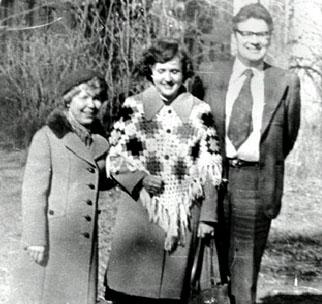
Автор с Людмилой и Кириллом Замараевым
Вот пример из совсем другой сферы. Кирилл с детства увлекался классической музыкой и при малейшей возможности бывал на концертах в Доме ученых. Со временем, став академиком, он был и куратором Дома ученых. Однажды после симфонического концерта его пригласил к себе Главный дирижер симфонического оркестра профессор А.М. Кац. Арнольд Михайлович с отчаянием рассказывал, что ведущие пианисты страны не хотят гастролировать в Доме ученых из-за плохого качества рояля, и эта молва уже прошла по столицам. Кирилл тут же предложил написать письмо в Министерство культуры и взялся добиться положительного решения. И действительно, новый зарубежный рояль появился в Доме ученых через некоторое время, и прекрасные пианисты снова с удовольствием приезжают выступать в ДУ. Когда я сижу в зале во время концертов, светлый образ Кирилла, моего незабвенного друга в науке и в жизни, приходит ко мне вместе со звуками музыки.
Его бесконечное мужество во время обрушившейся на него неизлечимой болезни позволило ему продолжать дело всей жизни и сохранило его улыбку даже в момент кончины. День его кончины стал навсегда связан со светлой памятью о моем Друге, скончавшемся в день моего рождения.
Г.И. Скубневская
ИХКиГ СО РАН, Новосибирск

Мемориальная комната академика К.И. Замараева открыта 20 мая 1999 года - в день 60-летия со дня его рождения. К этой дате была приурочена Международная конференция "Физические методы для исследования катализа на молекулярном уровне", посвященная памяти Кирилла Ильича. В создании мемориала принял участие Международный благотворительный научный Фонд им. К.И. Замараева, созданный по инициативе и при непосредственном участии вдовы Кирилла Ильича - Людмилы Александровны Замараевой. Фонд учредил стипендии, исследовательские гранты и премии им. К.И. Замараева для молодых ученых. Хранящиеся в Фонде дипломы, награды, фотоархивы и личные вещи, предоставленные семьей Кирилла Ильича, выставлены в витринах мемориальной комнаты. Здесь же находится уникальная научная библиотека, собранная Кириллом Ильичом.
Небольшая музейная экспозиция рассказывает о жизни и деятельности академика Кирилла Ильича Замараева - потомственного ученого. Кирилл Замараев родился 20 мая 1939 года в Москве. Его дед - тоже Кирилл Ильич - преподавал начертательную геометрию сначала в Санкт-Петербургском университете, а затем в Томском Технологическом институте (сейчас Политехнический университет). Отец - Илья Кириллович Замараев, крупный советский инженер-химик, получил Государственную премию во время великой Отечественной войны за пуск первого отечественного цеха по производству синильной кислоты, что являлось в то время чрезвычайно сложной технологической задачей. Мать Кирилла Ильича, Замараева Вера Львовна, была тоже химиком по образованию, но всю свою жизнь посвятила семье и воспитанию сына.
Блестящие способности к наукам проявились у Кирилла еще в школе (это была первая в Москве специализированная английская школа, в которую Кирилл Замараев поступил сразу в четвертый класс). В музее хранится золотая медаль, которую он получил по окончании школы. После школы Замараев поступает в Московский химико-технологический институт им. Д.И. Менделеева, становится сталинским стипендиатом, но после третьего курса переходит в МФТИ, чтобы всерьез заняться химической физикой. В витрине музея хранится конспект лекций по статической физике, которые он слушал в Московском Физтехе. В архивах музея хранятся рабочие тетради аспиранта Физтеха Кирилла Замараева и спектры ЭПР, снятые им во время учебы в аспирантуре. Огромную роль в становлении Кирилла Ильича как ученого сыграли в то время его научный руководитель академик В.В. Воеводский, а позднее академик Н.Н. Семенов.
Московский период (1956-1976 гг.) его жизни и деятельности отражен на фотопланшетах. Кирилл Ильич Замараев работает в Институте химической физики АН СССР (ныне имени академика Н.Н. Семенова) и преподает в МФТИ.
В 1976 г. К.И. Замараев избран членом-корреспондентом АН СССР. В начале 1977 г. по приглашению академика Г.К. Борескова Кирилл Ильич с семьей и большой командой молодых выпускников МФТИ переехал в Новосибирск.
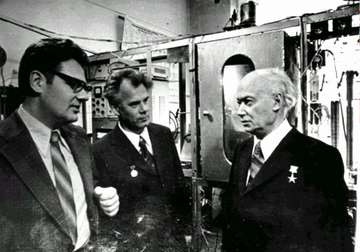
Сразу же после переезда К.И. Замараева в Институт катализа огромная научно-организационная работа легла на его плечи как заместителя директора Института по науке и одновременно заведующего отделом физических методов, который стал быстро прогрессировать после его приезда. Он совмещает эту работу с преподаванием в Новосибирском государственном университете, где заведует кафедрой физической химии. В институтах СО РАН сейчас работает много выпускников НГУ, которые помнят его блестящие лекции и семинары.
В 1984 г. после внезапной смерти создателя и первого директора Института катализа академика Г.К. Борескова К.И. Замараев становится директором Института. Начиная с 1986 г. К.И. Замараев является генеральным директором Межотраслевого научно-технического комплекса (МНТК) "Катализатор", объединявшего вплоть до конца существования СССР все основные научные и технологические организации, а также некоторые заводы, обеспечивавшие Советский Союз новыми поколениями промышленных катализаторов.
В 1987 г. К.И. Замараев избирается действительным членом АН СССР. В музее находятся его правительственные награды, почетные медали Академии наук СССР, а также удостоверение действительного члена АН СССР.
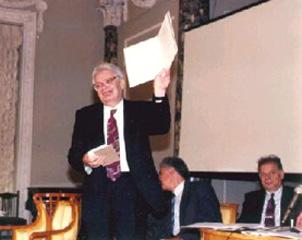
Десятилетие с середины восьмидесятых до середины девяностых годов ознаменовалось для К.И. Замараева огромным признанием его научных заслуг со стороны международного научного сообщества. Он становится иностранным членом Академий наук Индии и Кореи, получает серебряную медаль Британского Королевского химического общества как "Выдающийся лектор столетия", избирается членом Академии Европы.
Его приглашают в качестве научного консультанта крупнейшие западные фирмы, предлагают выгоднейшие условия контрактов для долгосрочной работы в США. В 1993 г. К.И. Замараев становится Президентом IUPAC - Международного Союза Теоретической и Прикладной Химии, а в 1995 г. удостаивается престижной немецкой награды для российских ученых - премии имени А.П. Карпинского. В музее хранятся дипломы и медали, а также ряд фотографий этого периода жизни.
Благодаря великолепным организаторским качествам, мужеству и принципиальности Кириллу Ильичу удалось провести Институт через годы тяжелых испытаний, связанных со сменой экономической и политической системы страны, сохранить сплоченную команду, успешно конкурирующую на отечественном и международном рынке новейших технологий.

Прошли годы после ухода К.И. Замараева из жизни. Его дело живет в его учениках. Сейчас Институтом катализа руководит ученик и соратник К.И. Замараева академик В.Н. Пармон. Д.ф.-м.н. Д.И. Кочубей руководит отделом физико-химических методов исследования, д.х.н. Е.П. Талзи - заведующий лабораторией исследования механизмов каталитических реакций, к.х.н. Ю.И. Аристов - заведующий лабораторией энергоаккумулирующих процессов и материалов.
Все, кто лично знал Кирилла Ильича, помнят его необыкновенную способность не падать духом даже в самых сложных жизненных ситуациях. Это проявилось и в период тяжелейшей его болезни - он улыбался всегда, и когда был в расцвете творческих и физических сил, и когда уже был тяжко болен. Характер Кирилла Ильича был совершенно железный, недаром вид спорта, которым он увлекался, был горный туризм.
Это можно видеть на многочисленных фотографиях, представленных в музее, которые хранят память о нем, как о выдающейся личности и замечательном человеке.
посвященного 65-летию со дня рождения
академика К.И. Замараева
9.30 Открытие семинара
9.45Академик В.Н. Пармон Институт катализа им. Г.К. Борескова СО РАН
К.И. Замараев: Жизнь, отданная науке и катализу
10.05Sir John Meurig Thomas
Royal Institution of Great Britain
New Nanoporous and Nanoparticle Catalysts
10.50 Перерыв
11.10Д.х.н. Н.М. Бажин
Институт химической кинетики и горения СО РАН
Эмиссия метана в атмосферу
11.30 Э.А. Дубан, К.П. Брыляков, д.х.н. Е.П. Талзи
Институт катализа им. Г.К. Борескова СО РАН
Cтроение и реакционная способность гидропероксо (LFe(OOH)) и алкилпероксо (LFe(OOR)) комплексов железа, предполагаемых ключевых интермедиатов селективного окисления углеводородов
11.50 Д.ф.-м.н. Б.Н. Плахутин
Институт катализа им. Г.К. Борескова СО РАН
Высокоспиновые структуры икосаэдрической симметрии: Уникальные особенности энергетического спектра состояний
12.10 Аспирант, стипендиат Международного благотворительного научного фонда
им. К.И. Замараева 2004 года А.Н. Усольцева
Институт катализа им. Г.К. Борескова СО РАН
Термодинамический анализ нуклеации углерода на поверхности металлов для процессов синтеза нанотрубок углерода
12.30 Перерыв
13.45 Возложение цветов к Мемориальной доске. Поездка на кладбище.
15.00 Концерт
15.30 Вручение дипломов лауреатам конкурса аспирантских стипендий Международного благотворительного научного фонда им. К.И. Замараева 2004 года
15.45 Воспоминания об академике К.И. Замараеве
К.х.н. Г.И. Скубневская, Институт химической кинетики и горения СО РАН,
"С тобой 40 лет в науке и без тебя..."
Академик Ю.Н. Молин, Институт химической кинетики и горения СО РАН
Академик Г.В. Сакович, Институт проблем химико-энергетических технологий СО РАН
Академик А.Э. Конторович, Институт геологии нефти и газа СО РАН
К.ф.-м.н. Л.А. Замараева, Международный благотворительный научный фонд
им. К.И. Замараева
17.00 Фуршет (холл 3го этажа, приглашаются все сотрудники Института)
Финансовую поддержку оказали:
Централизованный фонд Института катализа
Институт химической кинетики и горения, группа химии атмосферы
Международный благотворительный научный фонд им. К.И. Замараева
Задолго до прекращения холодной войны Советский Союз стал неотъемлемой частью ИЮПАК. В настоящее время Российская Академия наук содействует продвижению идей и принципов ИЮПАК в российском химическом сообществе. Редакция журнала Chemistry International обратилась к Петру Федотову, российскому члену этой организации, с просьбой кратко представить историю Академии, ее Национального комитета российских химиков, а также привести примеры недавних совместных проектов России и ИЮПАК.
Более семидесяти лет Россия и Советский Союз участвовали в деятельности ИЮПАК. Формально эти взаимоотношения начались в 1931 году, когда Академия наук СССР стала Национальной организацией-участницей ИЮПАК. С этого времени три российских академика выступали в качестве президентов ИЮПАК: В.Н. Кондратьев в 1967-1969 гг., В.А. Коптюг в 1987-1989 гг. и К.И. Замараев в 1993-1995 гг. Кроме того, действительные и ассоциированные члены организации с российской стороны активно работали во всех подразделениях ИЮПАК. Например, В.А. Кабанов был президентом Макромолекулярного отделения с 1979 по 1981 г., К.И. Замараев - президентом Отделения физической химии с 1987 по 1989 г., а И.П. Белецкая - президентом Отделения органической химии с 1991 по 1993 г. На протяжении многих лет Ф.А. Кузнецов активно участвовал в деятельности комитета CHEMRAWN (химические исследования для нужд мирового сообщества), а в настоящее время О.М. Нефедов является избранным членом Бюро ИЮПАК, Исполнительного комитета Бюро ИЮПАК и Экспертного комитета.
Было бы уместно обратиться к истории самой Российской Академии наук. Она была основана в 1724 году в Санкт-Петербурге в соответствии с указом Петра Великого и по постановлению Правящего Сената. В 1889 году Академия наук выступила одним из учредителей Международного союза академий - прототипа Международного ученого совета (1919-1931), который позднее был преобразован в ICSU, Международный совет научных союзов (1931-1998), а теперь существует как Международный совет по науке.
 |
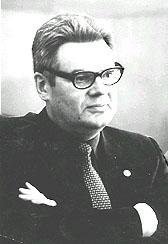 |
В.Н. Коптюг - Президент ИЮПАК |
К.И. Замараев - Президент ИЮПАК |
Академия наук постоянно развивалась: после 1917 года в Российской Федерации, а после 1924 г. в Советском Союзе. Советское правительство в своем декрете 1925 года признало Академию "высшей всесоюзной научной организацией", присвоило ей новое название (Академия наук СССР) и интегрировало ее в систему Академий союзных республик. В 1991 году, в связи с распадом Советского Союза, Академия изменила свой статус и получила свое первоначальное имя Российской Академии наук. В настоящее время Академия объединяет 366 научно-исследовательских институтов по всей России, которые занимаются исследованиями в фундаментальных областях современной науки. В этих исследовательских институтах и лабораториях собраны лучшие научные силы, ученые с мировым именем и талантливая молодежь. Девять специализированных отделений Академии (в том числе отделение химии и материаловедения) представляют собой научно-организационные центры, каждый из которых объединяет членов Академии, занятых в одной из смежных областей науки, а также сотрудничающие с институтами организации и другие научные и вспомогательные органы Академии. Три региональных отделения (Сибирское, Уральское и Дальневосточное), включающие в себя многочисленные региональные научные центры, также входят в состав Российской Академии наук.
Национальный комитет российских химиков (председатель О.М. Нефедов, заместитель председателя Б.Ф. Мясоедов) отвечает за связи между ИЮПАК и Российской Академией наук. Однако, Национальный комитет объединяет ведущих химиков не только из Академии, но также из промышленности и университетов, что способствует продвижению идей ИЮПАК во всех российских химических сообществах. Национальный комитет работает в соответствии с программой ИЮПАК по аффилиированию в России, которая содействует развитию национальной инфраструктуры ИЮПАК и помогает выяснить общественное мнение по вопросам, касающимся ИЮПАК. Такая инфраструктура может также оказаться полезной для подготовки конгрессов ИЮПАК или финансируемых им симпозиумов.
Национальный комитет помог провести в российских научных центрах серию поддержанных ИЮПАК конференций, среди них "Международная конференция памяти К.И. Замараева по физическим методам в каталитических исследованиях на молекулярном уровне" (1999 г., Новосибирск) и "Перспективы органической и металлоорганической химии" (1999 г., Москва). При финансовой поддержке Германского химического общества комитет также содействовал участию молодых российских ученых в 37-м конгрессе ИЮПАК, который проходил в Берлине в 1999 г. Особого упоминания заслуживает международная конференция по химическим исследованиям для нужд мирового сообщества под названием "Химия и устойчивое развитие для обеспечения чистой окружающей среды, нулевых отходов и наивысшей энергетической эффективности" (CHEMRAWN VIII), которая была организована В.А. Коптюгом и О.М. Нефедовым и проведена в сентябре 1992 года в Москве. В.А. Коптюг содействовал также расширению участия советских и российских ученых (например, из Сибирского отделения Академии наук) в работе подразделений и комиссий ИЮПАК.
В девяностых годах Академия наук принимала участие в подготовке серии книг ИЮПАК "Химия для 21-го века". К.И. Замараев был первым председателем Редакционного консультативного совета, а И.П. Белецкая - членом этого совета. Члены Национального комитета также поддерживают представление научных и образовательных проектов в ИЮПАК. Кроме того, Б.Ф. Мясоедов, И.П. Белецкая и С.Д. Варфоломеев выступали в качестве представителей Российской национальной организации-участницы ИЮПАК на последнем семинаре по химическому оружию, проведенном в Норвегии в июле 2002 года.
Крупные национальные форумы по химии (конгрессы им. Менделеева) проводятся в России каждые четыре - пять лет. После распада Советского Союза первый конгресс (XV Менделеевский конгресс по общей и прикладной химии) состоялся в Белоруссии (Минск, май 1993 г.) при активной поддержке Академии наук Белоруссии. На этом конгрессе была учреждена Менделеевская Федерация химических обществ Содружества Независимых Государств (СНГ). Профессор Дж. Джортнер (президент ИЮПАК в 1998-1999 гг. ) и доктор А. Хайес (президент ИЮПАК в 2000-2001 гг.) были участниками XVI Конгресса им. Менделеева в 1998 г. Последний XVII-й Менделеевский съезд по общей и прикладной химии, финансируемый IUPAC, прошел в Казани 21-26 сентября 2003 года. В его работе приняли участие профессор П. Стейн (президент ИЮПАК), профессор Л. Сиднес (вице-президент ИЮПАК) и профессор Х. Отаки (член бюро ИЮПАК и его Исполнительного комитета), а также лауреаты Нобелевской премии по химии Ж.-М. Лена (Франция) и Р. Нойори (Япония). Состоялась дискуссия за круглым столом по теме "Современное состояние химии на постсоветском пространстве и проблемы международного сотрудничества" с участием руководства ИЮПАК и президентов национальных химических обществ СНГ, Балтии, США, Франции, ФРГ, Великобритании, Японии и Китая.(
Следует отметить, что сейчас Российская Академия уделяет особое внимание сотрудничеству с научными организациями СНГ и Балтии. Академия также продолжает участвовать в деятельности Международной ассоциации академий наук (IAAS), тем самым объединяя усилия национальных академий республик Азербайджан, Армения, Белоруссия, Вьетнам, Грузия, Киргизия, Молдавия, Россия, Таджикистан, Туркменистан, Узбекистан, Украина. Б.Е. Патон, президент Украинской Академии наук, является президентом IAAS, а также действительным членом Российской Академии наук. IAAS проводит ежегодные совещания президентов национальных академий. По инициативе IAAS, главы правительств стран-участниц СНГ подписали соглашение о сотрудничестве по научным и технологическим проектам.
Традиционно Академия наук СССР являлась издателем всесоюзных научных журналов по химии. Все эти журналы издаются теперь в России. Тем не менее, статьи исследователей из СНГ и Балтии широко публикуются в России. Более того, появляются новые журналы, способствующие международному научному сотрудничеству. Журнал под названием "Mendeleev Communications" был учрежден в 1991 году Российской Академией наук и Королевским химическим обществом Великобритании. В этом журнале публикуются предварительные отчеты о новых работах по химии из России и других стран.
До 1991 года (до распада Советского Союза) практическая реализация наиболее важных научных идей осуществлялась в рамках программ, получавших всесоюзную финансовую поддержку. В настоящее время наука в республиках бывшего Советского Союза испытывает финансовые, кадровые, материальные и технические трудности. Тем не менее, Россия проявляет высокую активность в научно-технической сфере. Следовательно, Россия должна направлять больше усилий на интеграцию и координирование научных сообществ и организаций в постсоветском пространстве для достижения общих целей.
Все вышесказанное имеет большое значение, принимая во внимание, что среди республик бывшего Советского Союза лишь Россия является полноправным членом ИЮПАК. Таким образом, Национальный комитет российских химиков имеет уникальную возможность способствовать распространению идей и принципов ИЮПАК во всем постсоветском пространстве. Кроме того, Национальный комитет может вовлекать в деятельность ИЮПАК ведущих химиков из этих республик.
Петр Федотов
Ученый секретарь
Национального комитета
российских химиков РАН
ncrc@mail.ru
Chemistry International,
January-February 2003, p. 10-11
Alkynes are highly energetic species, and in catalytic reactions they normally couple with other molecules to give complex compounds via cleavage of one or two ( bonds. However, most studies on alkyne C(C bond cleavage have focused on stoichiometric organometallic reactions. And the few studies that have focused on catalytic reactions have required organic promoters such as 2-aminopyridine or 2-aminophenol to facilitate alkyne cleavage. Chemistry professor Rai-Shung Liu and coworkers at National Tsing-Hua University in Taiwan, now report a ruthenium-catalyzed method that splits terminal ethynylalcohols attached to a variety of alkyl and aryl substrates into terminal alkenes and GO without organic promoters [J. Am. Chem. Soc., 125, 9294 (2003)]. The best results were achieved with a tris(pyrazolyl)-borate ruthenium complex in toluene using lithium triflate as a Lewis acid cocatalyst. The researchers used isotopic labeling studies to elucidate a proposed mechanism that includes generation of a metal-vinylidene intermediate. They are using their findings to develop new catalytic processes.
By using uniformly aligned polyurethane films as templates, chemistry professor Kyung Byung Yoon and coworkers at Sogang University, Seoul, South Korea, can control the synthesis of multicrystal arrays of cilicalite-1, a type of zeolite [Science, 301, 818 (2003)]. The researchers also found that they can change crystal orientation by varying the type of polyurethane film used. The majority of silicalite-l crystals Yoon's group grew on one type of polymer-coated glass were oriented with their smallest surface touching the glass and their larger surfaces touching one another (shown) в not unlike standing eggs on end. In contrast, silicalite-1 crystals grown on bare glass plates were oriented with their largest surface contacting the glass. When Yoon's team altered the basicity of the gel used to apply the polyurethane film, they were able to grow arrays of crystals of different shapes and sizes. They hope these results will lead to applications for zeolites in innovative materials and devices.
C&EN / AUGUST 11. 2003 21


